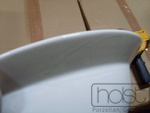Defects of glaze

Glaze noses and glaze gradients in porcelain
Glazed noses (irregular)
The item was not sufficiently "swivelled" during the glazing process. When at rest, the viscous glaze sinks downwards as it dries out and shows noticeable noses and wrinkles. Under light refraction, these irregularities become particularly visible and the porcelain loses its appearance. Glaze noses are caused by unclean, usually too fast work when glazing the ware. The body has too little time to absorb the liquid glaze. This production step is therefore carried out with a lack of care and is a clear defect!
Smaller glaze noses, which are often only visible against the light or by swivelling the item, and which can usually be seen on rising flags or edges, are difficult to avoid because the flow rate of the glaze on the body varies depending on the gradient of the wall. Even careful swivelling of the product often cannot rule out the formation of small noses and is not a defect. Whether irregular glaze noses can be labelled as defects is generally a matter of pricing, which in turn makes the sorting criteria of the porcelain more generous for cheaper goods than for high-quality items.
Glaze seams (straight glaze noses)
If a glaze nose stretches like a straight line (seam) along the length or height of a porcelain body, it is usually a bowl or large, pressed plate that has been produced in a plaster mould. There can be three reasons for this visual appearance.
1st possibility: The plaster mould "needs" a minimal amount of sodium silicate, which acts as a separating agent so that the porcelain does not bond with the plaster mould. If the porcelain mass is now pressed into the production mould under high pressure, even a very low dosage of sodium silicate can cause the mass to bundle the silicates like a tsunami wave and propel them in front of it. At the contact point of the body, usually at the opening edge of the mould, a compressed amount of sodium silicate is formed, which only makes the glaze nose visible after hard firing.
2nd possibility: The plaster mould has been used too often. Minimal signs of wear have formed at the opening points. Here too, the fault cannot be detected during the manufacturing process.
3rd possibility: The plaster mould was made slightly "unclean". Just a tenth of a millimetre is enough to give the porcelain item a "glaze nose" at the end.
4th possibility: The phenomenon of "seam formation" also occurs primarily with compression-moulded articles. In this case, the casting compound - the slagger - penetrates the plaster mould from two different directions during the moulding production process and joins at the opposite point of the inlet opening. The culprit for the seam formation is a release agent that is dosed too high, in Asia predominantly sodium silicate. Unfortunately, the sodium silicate also acts as a release agent at the opposite connection point of the porcelain mass and then causes a minimal thickening, which then becomes visible as a glaze seam after firing.
Regardless of which possibility is ultimately the cause of the glaze nose, it is and remains a purely visual impression that does not affect the usage properties of an item. Due to customers' strict price specifications, a factory is quickly tempted to use a mould 20, 50 or 100 times more than the degree of wear allows. In this way, up to 15% of the production costs can quickly be saved. Accordingly, we also realise here that the perception/complaint ability of such glaze noses ultimately depends on the price.
